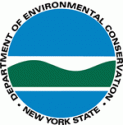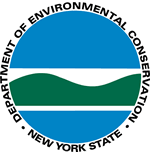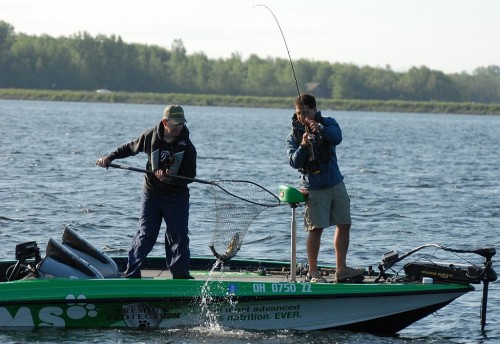The Lake Champlain Fish and Wildlife Management Cooperative will be applying lampricide to portions of four tributaries to Lake Champlain and a delta complex during the months of September and October.
 The U.S. Fish and Wildlife Service, Vermont Department of Fish and Wildlife, and New York State Department of Environmental Conservation will be treating the delta complex at the mouths of the Little Ausable and Ausable rivers, and the Boquet River, Mount Hope Brook, and Putnam Creek in New York. The Poultney River, which borders both states, including its Hubbardton River tributary in Vermont, will also be treated. Treatments are scheduled to begin with the delta complex in New York on September 7th. Lake level and weather conditions may affect scheduling and could result in the last treatment extending into October. These treatments are part of the Cooperative’s long-term sea lamprey control program for Lake Champlain. While trout and salmon populations of the lake are the primary beneficiaries of these efforts, lake sturgeon, walleye, and many other species also profit from sea lamprey control.
The U.S. Fish and Wildlife Service, Vermont Department of Fish and Wildlife, and New York State Department of Environmental Conservation will be treating the delta complex at the mouths of the Little Ausable and Ausable rivers, and the Boquet River, Mount Hope Brook, and Putnam Creek in New York. The Poultney River, which borders both states, including its Hubbardton River tributary in Vermont, will also be treated. Treatments are scheduled to begin with the delta complex in New York on September 7th. Lake level and weather conditions may affect scheduling and could result in the last treatment extending into October. These treatments are part of the Cooperative’s long-term sea lamprey control program for Lake Champlain. While trout and salmon populations of the lake are the primary beneficiaries of these efforts, lake sturgeon, walleye, and many other species also profit from sea lamprey control.
Larval sea lamprey live in rivers and on deltas for four years before transforming to their parasitic phase and emigrating to Lake Champlain where their effect on the fishery becomes apparent. One of the Cooperative’s Integrated Pest Management approaches is to apply selective pesticides (lampricides) to rivers and deltas in prescribed and precise concentrations. The concentrations used are carefully chosen and monitored to ensure effective elimination of sea lamprey larvae and protection of non-target species. TFM (3-trifluoromethyl-4-nitrophenol) will be applied in the rivers for 12-14 hours depending on conditions.
 This year, for the first time in the Lake Champlain Basin, a second lampricide, Bayluscide 20% Emulsifiable Concentrate, is being included in the application on the Boquet River. The use of 1% Bayluscide with TFM reduces the amount of TFM needed by about 40%, resulting in a reduction of total lampricide applied and substantial cost savings. The delta area around the Little Ausable River and Ausable River mouths will be treated with Granular Bayluscide: lampricide-coated sand grains that dissolve after sinking to the bottom where they effectively kill sea lamprey larvae.
This year, for the first time in the Lake Champlain Basin, a second lampricide, Bayluscide 20% Emulsifiable Concentrate, is being included in the application on the Boquet River. The use of 1% Bayluscide with TFM reduces the amount of TFM needed by about 40%, resulting in a reduction of total lampricide applied and substantial cost savings. The delta area around the Little Ausable River and Ausable River mouths will be treated with Granular Bayluscide: lampricide-coated sand grains that dissolve after sinking to the bottom where they effectively kill sea lamprey larvae.
Our toll-free number (888-596-0611) provides information on the treatment schedule for each of the treatments, progress reports, updates on treatments, and water use advisories.
Temporary water use advisories will be in effect for each of the treatments to minimize human exposure to affected waters. Each state’s Department of Health recommends that the treated river and lake water not be used for drinking, swimming, fishing, irrigation, or livestock watering while the advisories are in effect.
 The treatments and water use advisories will have no effect on most residents in the Champlain Basin and no municipal water supply systems will be affected. Cooperative staff have identified all landowners with property in the affected areas. A letter was sent to residents informing them of the planned treatment and asking them if they or their livestock use water from a surface supply that will be affected by the treatment. Days before the treatments begin, another letter will be sent to inform residents of the impending treatment and to arrange any water usage accommodations.
The treatments and water use advisories will have no effect on most residents in the Champlain Basin and no municipal water supply systems will be affected. Cooperative staff have identified all landowners with property in the affected areas. A letter was sent to residents informing them of the planned treatment and asking them if they or their livestock use water from a surface supply that will be affected by the treatment. Days before the treatments begin, another letter will be sent to inform residents of the impending treatment and to arrange any water usage accommodations.
Local television and radio stations will broadcast the dates when advisories begin and expire. The treatment schedule is subject to change as weather conditions, stream flows, or logistical issues may arise during the treatments. Residents will be kept apprised of any such changes through these media.
Annual assessments show sea lamprey wounding rates have been reduced from a high for landlocked Atlantic salmon of 79 wounds per 100 fish in 2003 to our management goal of 15 per 100 fish, reached for the first time in 2010. The lake trout wounding rate of 99 wounds per 100 fish seen in 2006 has been brought down to 40 per 100 fish in 2010. Several control initiatives are underway that will further reduce the sea lamprey population and reduce their impacts on Lake Champlain’s fish populations.
Sea lamprey control generates a favorable economic benefit/cost ratio by increasing angling opportunities and the time that boaters and anglers spend in the Lake Champlain area.
Communities and residents that utilize the following bodies of water should consult the advisory table below:
| WATER USE ADVISORY AREAS |
| Stream |
Length of Advisory Area in Miles |
|
Application Point to Stream Mouth |
Lake Area North of Stream Mouth |
Lake Area South of Stream Mouth |
| Ausable/Little Ausable Delta, NY |
NA |
2.0 |
2.0 |
| Boquet River, NY |
2.6 |
2.0 |
2.0 |
| Poultney (NY-VT) / Hubbardton River, VT |
10.5/2.0 |
20.0* |
NA |
| Mount Hope Brook, NY |
2.4 |
4.0** |
2.0 |
| Putnam Creek, NY |
9.2 |
1.5 |
1.0 |
* includes the South lake from South Bay outlet to Larabees Point
** includes all of South Bay
Please contact Bradley Young, of the US Fish & Wildlife Service at (802) 872-0629 x19 if you have any questions.
Previously: Sea Lamprey Control Improves Lake Champlain Fisheries
 With the onset of winter, the thoughts of many anglers often turn to ice fishing and the New York State Department of Environmental Conservation (DEC) today reminds ice anglers about a recent change to the Environmental Conservation Law.
With the onset of winter, the thoughts of many anglers often turn to ice fishing and the New York State Department of Environmental Conservation (DEC) today reminds ice anglers about a recent change to the Environmental Conservation Law.

 The U.S. Fish and Wildlife Service, Vermont Department of Fish and Wildlife, and New York State Department of Environmental Conservation will be treating the delta complex at the mouths of the Little Ausable and Ausable rivers, and the Boquet River, Mount Hope Brook, and Putnam Creek in New York. The Poultney River, which borders both states, including its Hubbardton River tributary in Vermont, will also be treated. Treatments are scheduled to begin with the delta complex in New York on September 7th. Lake level and weather conditions may affect scheduling and could result in the last treatment extending into October. These treatments are part of the Cooperative’s long-term sea lamprey control program for Lake Champlain. While trout and salmon populations of the lake are the primary beneficiaries of these efforts, lake sturgeon, walleye, and many other species also profit from sea lamprey control.
The U.S. Fish and Wildlife Service, Vermont Department of Fish and Wildlife, and New York State Department of Environmental Conservation will be treating the delta complex at the mouths of the Little Ausable and Ausable rivers, and the Boquet River, Mount Hope Brook, and Putnam Creek in New York. The Poultney River, which borders both states, including its Hubbardton River tributary in Vermont, will also be treated. Treatments are scheduled to begin with the delta complex in New York on September 7th. Lake level and weather conditions may affect scheduling and could result in the last treatment extending into October. These treatments are part of the Cooperative’s long-term sea lamprey control program for Lake Champlain. While trout and salmon populations of the lake are the primary beneficiaries of these efforts, lake sturgeon, walleye, and many other species also profit from sea lamprey control. This year, for the first time in the Lake Champlain Basin, a second lampricide, Bayluscide 20% Emulsifiable Concentrate, is being included in the application on the Boquet River. The use of 1% Bayluscide with TFM reduces the amount of TFM needed by about 40%, resulting in a reduction of total lampricide applied and substantial cost savings. The delta area around the Little Ausable River and Ausable River mouths will be treated with Granular Bayluscide: lampricide-coated sand grains that dissolve after sinking to the bottom where they effectively kill sea lamprey larvae.
This year, for the first time in the Lake Champlain Basin, a second lampricide, Bayluscide 20% Emulsifiable Concentrate, is being included in the application on the Boquet River. The use of 1% Bayluscide with TFM reduces the amount of TFM needed by about 40%, resulting in a reduction of total lampricide applied and substantial cost savings. The delta area around the Little Ausable River and Ausable River mouths will be treated with Granular Bayluscide: lampricide-coated sand grains that dissolve after sinking to the bottom where they effectively kill sea lamprey larvae. The treatments and water use advisories will have no effect on most residents in the Champlain Basin and no municipal water supply systems will be affected. Cooperative staff have identified all landowners with property in the affected areas. A letter was sent to residents informing them of the planned treatment and asking them if they or their livestock use water from a surface supply that will be affected by the treatment. Days before the treatments begin, another letter will be sent to inform residents of the impending treatment and to arrange any water usage accommodations.
The treatments and water use advisories will have no effect on most residents in the Champlain Basin and no municipal water supply systems will be affected. Cooperative staff have identified all landowners with property in the affected areas. A letter was sent to residents informing them of the planned treatment and asking them if they or their livestock use water from a surface supply that will be affected by the treatment. Days before the treatments begin, another letter will be sent to inform residents of the impending treatment and to arrange any water usage accommodations.




